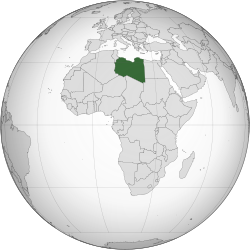
Back ليبيا وأسلحة الدمار الشامل Arabic Armas de destrucción masiva en Libia Spanish Armes de destruction massive en Libye French נשק להשמדה המונית בלוב HE Libya dan senjata pemusnahan massal ID Líbia e as armas de destruição em massa Portuguese
| Libya | |
|---|---|
 | |
| Nuclear program start date | 1969 |
| First nuclear weapon test | None |
| First fusion weapon test | None |
| Last nuclear test | None |
| Largest yield test | None |
| Total tests | None |
| Peak stockpile | None |
| Current stockpile | None; the program was dismantled in 2003. |
| Maximum missile range | 300 km (Scud-B) |
| NPT signatory | Yes |
Libya pursued programs to develop or acquire weapons of mass destruction from when Muammar Gaddafi seized control of Libya in 1969 until he announced on 19 December 2003 that Libya would voluntarily eliminate all materials, equipment and programs that could lead to internationally proscribed weapons. This included weapons of mass destruction (nuclear, chemical and biological weapons) and long-range ballistic missiles.[1][2][3]
Libya under King Idris signed the Nuclear Non-Proliferation Treaty (NPT) in 1968 and Gaddafi ratified it in 1975, and concluded a safeguards agreement with the International Atomic Energy Agency (IAEA) in 1980.[4] The United States and the United Kingdom assisted Libya in removing equipment and material from its nuclear weapons program, with independent verification by IAEA.[3]
In 1982, Libya ratified the Biological Weapons Convention.
In 2004, Libya acceded to the Chemical Weapons Convention,[5] and declared 24.7 metric tonnes of mustard gas, 1,390 metric tonnes of chemical precursors for making sarin, as well as 3,563 unloaded chemical weapon munitions (aerial bombs).[6][7] The OPCW set January 2014 as the deadline for the full destruction of Libya's chemical weapons.[8] Libya began destroying its chemical stockpiles and munitions later in 2004,[9] but it missed deadlines for converting one chemical weapons production facility to peaceful use and for destroying its stockpile of mustard agent.[10] In October 2014, Libya asked for foreign assistance to transport its 850 tonne stockpile of precursor chemicals for making nerve gas out of Libya for destruction.[11] In February 2015, Libyan military sources told media that unidentified armed men had captured large amounts of Libya’s chemical weapons, including mustard gas and sarin.[12][13] Destruction of Libya's chemical weapon precursors was completed in November 2017.[14]
Libya signed the Treaty on the Prohibition of Nuclear Weapons on 20 September 2017, but has not ratified it.[15]
- ^ Chronology of Libya's Disarmament and Relations with the United States, Arms Control Association.
- ^ News Update on IAEA & Libya Archived 2012-03-28 at the Wayback Machine, Chronology of Key Events, (December 2003 - September 2008), International Atomic Energy Agency.
- ^ a b Rohlfing, Joan. "Libya: Nuclear Programme Overview". Nuclear Threat Initiative. Retrieved 11 August 2011.
- ^ GOV/2004/12, Implementation of the NPT Safeguards Agreement of the Socialist People's Libyan Arab Jamahiriya, Report by the Director General, International Atomic Energy Agency, 20 February 2004.
- ^ The Chemical Weapons Convention Enters Into Force in Libya Archived 2018-04-08 at the Wayback Machine, Organisation for the Prohibition of Chemical Weapons, 2 February 2004.
- ^ OPCW, Libya: Facts and Figures Archived 2013-09-27 at the Wayback Machine
- ^ "Libya's CW Capabilities" (PDF). June 2011.
- ^ "Libya Completes Destruction of Its Category 1 Chemical Weapons". OPCW. 4 February 2014.
- ^ Zanders, Jean Pascal (19 May 2011). "Destroying Libya's Chemical Weapons: Deadlines and Delays". James Martin Center for Nonproliferation Studies (CNS). Retrieved 13 August 2011.
- ^ Zanders, Jean Pascal (May 19, 2011). "Uprising in Libya: The False Specter of Chemical Warfare". James Martin Center for Nonproliferation Studies (CNS). Retrieved 13 August 2011.
- ^ Cite error: The named reference
SPwas invoked but never defined (see the help page). - ^ Cite error: The named reference
Al-Awsatwas invoked but never defined (see the help page). - ^ Cite error: The named reference
northafricapostwas invoked but never defined (see the help page). - ^ "OPCW Director-General Praises Complete Destruction of Libya's Chemical Weapon Stockpile". www.opcw.org. Retrieved 2018-02-10.
- ^ "UNODA Treaties". treaties.unoda.org.
